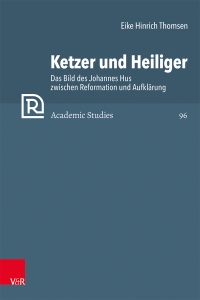 Der 1415 auf dem Konstanzer Konzil als Ketzer verbrannte Johannes Hus wurde vor der Reformation gemeinhin als ein Häretiker betrachtet. Mit Luther und der anbrechenden Reformation begann jedoch ein Umdeutungsprozess, der zu einer völligen Neubewertung von Hus führte. Bereits früh wurde er auf Seiten der Reformation als Heiliger, Märtyrer und Vorläufer Luthers betrachtet. Auf römischer Seite galt Hus jedoch weiterhin als prototypische Ketzergestalt. In einem ersten Teil der Studie untersucht Eike Hinrich Thomsen die Prozesse und Ereignisse, die dazu geführt haben, dass sich das Bild von Hus mit der beginnenden Reformation nachhaltig ändern sollte. Ein zweiter Teil verfolgt einzelne Rezeptionsstränge, die bis in das 18. Jahrhundert hineinreichen. Neben der starken lutherischen Hus-Rezeption werden auch andere Gruppen wie Reformierte, „radikale Reformer“ oder Katholische untersucht. Über die schriftlichen Quellen hinaus werden zahlreiche bildliche und materielle Quellen in die Untersuchung miteinbezogen.
Der 1415 auf dem Konstanzer Konzil als Ketzer verbrannte Johannes Hus wurde vor der Reformation gemeinhin als ein Häretiker betrachtet. Mit Luther und der anbrechenden Reformation begann jedoch ein Umdeutungsprozess, der zu einer völligen Neubewertung von Hus führte. Bereits früh wurde er auf Seiten der Reformation als Heiliger, Märtyrer und Vorläufer Luthers betrachtet. Auf römischer Seite galt Hus jedoch weiterhin als prototypische Ketzergestalt. In einem ersten Teil der Studie untersucht Eike Hinrich Thomsen die Prozesse und Ereignisse, die dazu geführt haben, dass sich das Bild von Hus mit der beginnenden Reformation nachhaltig ändern sollte. Ein zweiter Teil verfolgt einzelne Rezeptionsstränge, die bis in das 18. Jahrhundert hineinreichen. Neben der starken lutherischen Hus-Rezeption werden auch andere Gruppen wie Reformierte, „radikale Reformer“ oder Katholische untersucht. Über die schriftlichen Quellen hinaus werden zahlreiche bildliche und materielle Quellen in die Untersuchung miteinbezogen.
The TOC and the front matter and other sample bits are available here.
Readers of the present volume are treated to a meticulous reception history of Johannes Hus both by Luther and others and by generations after the Magisterial Reformers lie mouldering in the ground.
How Hus was turned from a heretic to a martyr opens the work and how that image guided the reception he received by the second generation of reformers and afterwards guides the first major division of the book (for the full TOC see above).
There’s an incredible amount of information about Hus in this portion of the volume related to his work as a musician as well as his work as a reformer before the Reformers. But his reception by the likes of Karlstadt and Munzer and Hubmaier and others is really something to behold.
The second major segment of the book focuses on things like how Hus was incorporated into Luther-memoria and the Protestant view of Hus and how the lines connecting him to Luther influenced that reception and his memory. It also discusses the various editions of Hus’s works by the likes of Flacius and Rabus and Walpurger.
The ghost of Hus was also dragged into use in connection to the Council of Trent, becoming a weapon in the hands of the Protestants commenting on that Catholic gathering.
And finally, the work ends with a look at the way that Hus’s death was utilized by martyrologists and apologists. In sum, poor Hus became nothing less than a central figure for identifying one’s confessional attachments. He became, for lack of a better term, a sort of shibboleth.
This is one of the most engaging and well developed revised dissertations that I’ve read in a while. It has everything that one would want in a book: good writing, an engaging narrative, and a terribly interesting subject.
I recommend this work to those who enjoy Church history. Particularly the history of the Reformation and the church to the Enlightenment.
I hope you’ll read it. I think you’ll want to once you take a look at the materials available on the publisher’s website.

You must be logged in to post a comment.